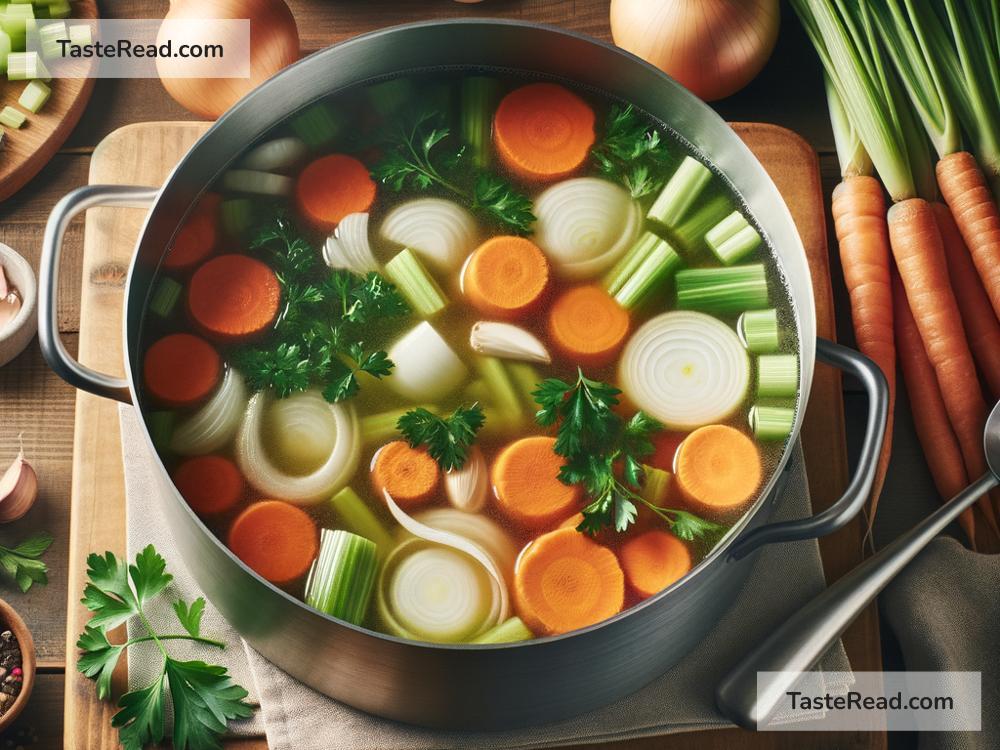How to Prepare Homemade Vegetable Stock
Making homemade vegetable stock is a simple yet rewarding kitchen activity that can take your meals to the next level. It’s perfect for adding flavor to soups, stews, risottos, sauces, and even pasta dishes. The best part? You can make it using basic vegetables you already have on hand, and it helps reduce food waste since you can use leftover veggie scraps. Whether you’re a seasoned cook or just starting your cooking journey, this recipe is easy to follow and budget-friendly.
In this article, we’ll cover how to prepare homemade vegetable stock step by step using everyday ingredients. Let’s get started!
What Is Vegetable Stock?
Vegetable stock is a liquid made by simmering vegetables and aromatic herbs in water. During the cooking process, the vegetables release their flavors, resulting in a nutrient-rich, savory broth. Unlike store-bought stocks, homemade vegetable stock allows you to control the ingredients, avoid preservatives, and customize the flavor to suit your taste.
Why Make Homemade Vegetable Stock?
- Cost-Effective: Instead of buying ready-made stock, you can use vegetable scraps or inexpensive produce.
- Customizable: You can adjust the recipe to create a light, mild stock or a deep, rich broth, depending on your needs.
- Reduced Waste: Put vegetable peels, stems, and scraps to good use instead of throwing them away.
- Healthier: Homemade stock is free from additives, preservatives, and excess sodium often found in store-bought options.
What Vegetables Can You Use for Stock?
You can use a variety of vegetables to make stock, but some lend themselves better to creating rich, balanced flavors. Here are common vegetables that work well:
- Onions: Add sweetness and depth.
- Carrots: Provide natural sweetness and color.
- Celery: Adds an earthy, slightly salty flavor.
- Garlic: Enhances the aroma.
- Leeks: Perfect for a mild onion-like flavor.
- Parsley: Adds freshness.
- Thyme: Gives a subtle herbal note.
Optional Additions:
– Mushroom stems (for an umami flavor).
– Tomato scraps (for acidity and color).
– Bay leaves (for a woody fragrance).
– Peppercorns (for mild spice).
– Ginger (for warmth).
What to Avoid:
Certain vegetables don’t work well in stock because they can overpower the flavor or turn bitter. Avoid using broccoli, cauliflower, cabbage, spinach, or asparagus.
Materials Needed
- Large pot (about 6-8 quarts)
- Cutting board and knife
- Measuring cups (optional)
- Colander or fine-mesh strainer
- Storage containers (for freezing or refrigerating stock)
Step-by-Step Recipe for Homemade Vegetable Stock
Ingredients:
– 2 onions (quartered)
– 2 carrots (roughly chopped)
– 2 celery stalks (roughly chopped)
– 1 garlic bulb (cut in half or 2-3 cloves peeled)
– 2 bay leaves
– 1 teaspoon black peppercorns
– A few sprigs of fresh parsley or thyme
– 10 cups of water (or enough to cover the vegetables completely)
Optional: Add mushroom stems, leeks, or tomato scraps for extra depth of flavor.
Instructions:
-
Prepare Your Vegetables:
Wash all the vegetables thoroughly to remove dirt or debris. No need to peel them—many nutrients and flavors come from the skins and peels. Roughly chop the vegetables into large chunks. -
Heat the Pot:
Place the large pot on the stove over medium heat. For extra flavor, you can sauté your onion, carrots, and celery in a little oil for 2-3 minutes before adding water. This step is optional but adds depth to the stock. -
Add Water and Flavorings:
Pour about 10 cups of water into the pot, enough to cover the vegetables completely. Add the garlic, bay leaves, peppercorns, parsley, and other herbs you’re using. -
Bring to a Boil:
Turn the stove to high heat and bring the pot to a rolling boil. -
Simmer:
Once the stock is boiling, lower the heat to a gentle simmer. Cover the pot partially with the lid and let it cook for 45 minutes to 1 hour. Simmering allows the vegetables to release their flavors slowly, making the stock rich and aromatic. -
Strain the Stock:
After cooking, turn off the heat and allow the stock to cool slightly. Use a colander or fine-mesh strainer to separate the liquid from the solid vegetables and herbs. Press the vegetables gently with a spoon to extract every bit of flavor. Discard the solids or compost them. -
Cool and Store:
Let the stock cool completely before storing it. Transfer it to airtight containers or freezer-safe bags. In the fridge, it will last for about 4-5 days. In the freezer, it can stay fresh for up to three months.
Tips and Variations
- To add a smoky flavor, roast your vegetables in the oven before using them in the stock.
- Freeze your vegetable scraps (like carrot peels, celery ends, and onion skins) over time to create stock when you have enough.
- If you prefer a stronger flavor, simmer the stock for up to two hours.
Conclusion
Homemade vegetable stock is an incredibly versatile ingredient that brings flavor, nutrition, and creativity into your cooking. It’s easy to make, helps reduce food waste, and can be tailored to fit your preferences. Whether you’re preparing a hearty soup or seasoning grains, this homemade stock recipe will elevate your dishes and bring satisfaction to your kitchen.
So, the next time you see leftover veggie scraps or want to avoid store-bought options, give this recipe a try. Happy cooking!


